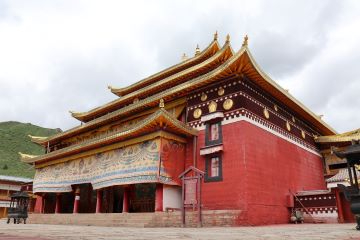Luding Bridge

Name in Chinese: 泸定桥 Lú Dìng Qiáo [lu din tʃau]
Duration of Tour: One Hour
Location: Luding County, Garze Autonomous Prefecture, Sichuan Province
Reputation: A National Four-star Scenic Area, A State-level Key Historical Cultural Relic Site under Protection
Luding Bridge was built in 1705. In order to improve the transportation efficiency in Tibetan area, Emperor Kangxi(1654-1722) gave an order to build up a bridge over Dadu River. The bridge is made of thirteen iron chains and paved with wooden boards. The iron chains each weigh at 1.6 tons with over 860 iron hoops. The bridge is 106.37 meters(349 feet) in length and 3 meters(10 feet) in width. It straddles Dadu River. The water below rushes rapidly. It is amazing that the bridge was built up more than 300 years ago without cranes. It is said that the chains were moved over the river from the east to the west by utilizing cable and derrick. The cable was made of bamboo, and the derrick was made of wood.
The bridge was named by Emperor Kangxi. Lu refers to Dadu River, and Ding means peaceful and settled. The emperor wished that Tibetan society would be stable and peaceful after the bridge was completed. Dadu River is also called Mo River. The bridge would have been named as Moding Bridge. But the emperor misread the river’s name, then he misnamed it.
Luding Bridge is listed as one of the five most famous ancient bridges in China. It is considered as a feat of bridge construction in the world. There are two towers standing on both sides of the bridge. The inscriptions on the towers are in the handwriting of Emperor Kangxi.
In 1850, a turbulent rebellion broke out in southern China. The rebels captured Najing, and established the Taiping Heavenly Kingdom. The top leader was Hong Xiuquan. His kingdom was destroyed by the Qing army in 1864. By the end of Taiping Civil War Period, General Shi Dakai launched his military expedition to Sichuan Province. In 1863, his army arrived at the place near the bridge, and was completely defeated.
In October 1934, the Red Army started the Long March from Jiangxi Province. The Red Army reached the bridge on May 29, 1935. Before the battle, the Kuomintang troop took away all the wooden board from the bridge. Twenty two soldiers of the Red Army crept on the chains, carrying rifles and wooden boards. Four of them were killed by the enemy. Finally, the bridge was occupied by the Red Army. It was a critical moment for the Red Army. If they could not pass through the bridge, the main force would be destroyed by the enemy chased.
Travel Tips
How to Get to Luding Bridge
Luding Bridge is located in the county seat of Luding, 230 km(143 miles) away from Chengdu. It takes about 3 hours to get to the bridge from Chengdu by a car.
Weather
The temperature in Luding ranges from 6℃(42.8°F) to 16℃(60.8°F) in spring, 15℃(59°F) to 26℃(78.8°F) in summer, 19℃(66.2°F) to 28℃(82.4°F) in autumn and 8℃(46.4°F) to 18℃(64.4°F) in winter. The rainy season in Sichuan lasts from July to August. Visitors should try to avoid going to western Sichuan in the rainy season.
Recommended Tour:
Twelve-Days West Sichuan Pure Land and Tibetan Culture Exploring Tour
Related Articles:
Daocheng Yading
Siguniang Mountain
Hailuogou Glacier
Altitude Sickness
Author: Tina Luo
Update:
